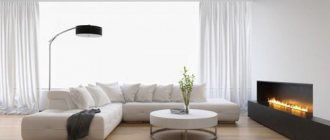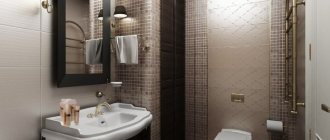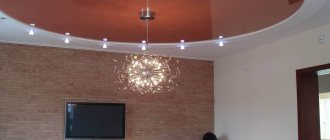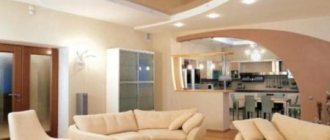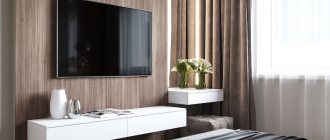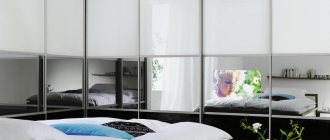Choosing a chandelier for a bedroom to go with a suspended ceiling creates difficulties for buyers. We need a certain design that will not damage the coating and beautifully emphasize the texture and color.
Beautiful and comfortable chandeliers for the bedroom are a key factor in creating good lighting.
What to choose first
The final selection of lighting equipment and decisions about its placement are made in advance. Despite the fact that the types and sizes of chandeliers for suspended ceilings offered to the modern consumer are diverse and sometimes force one to make a spontaneous decision by purchasing something out of the ordinary, one should not purchase this product at the last moment.
- The fact is that master installers must have a ready-made project and technical characteristics of the future chandelier on hand.
- This will help to correctly cut the material chosen for the ceiling and prevent it from overheating or catching fire.
- Any material used to install a stretch ceiling is highly sensitive to heat.
When installing some types of lamps too close to the fabric surface, the latter may not only show ugly yellow or black circles, but also irreversible deformation, threatening a potential fire.
Therefore, you cannot buy a chandelier without consultation and final approval of the craftsmen who are renovating the entire room.
Lighting accents
Using lighting in the interior of a room, you can add some design accents.
Thus, LED strips are often used to emphasize the geometric shapes and contours of a room. They are attached using special double-sided tape. If you want to focus on the design of the lamp itself, then you can create an entire composition from several sources of non-standard shapes and bright colors. Spots are often used to complete the interior. For such structures, you can easily change the direction of location, which allows you to separately highlight different areas in the room (workplace, pieces of furniture).
Key rules for choosing a chandelier
Deciding on the shape of the device and the type of lighting is only the first step in the process of selecting the necessary product. Those chandeliers in a suspended ceiling look great in the interior of any room, when installing them the owners were guided not only by their personal preferences, but also by the rules that professional designers and electricians never neglect.
The length of the entire chandelier (from the mounting point to its lowest element) should not be more than 1/4 of the distance from the floors to the ceiling on which it will be installed. So, for example, if this value is 260 cm, then the maximum possible length of the chandelier will be: 260:4 = 65 cm.
Other important requirements for chandeliers are:
- The material should not generate excessive heat;
- Energy-saving, or better yet, LED lamps are preferable;
- It is prohibited to use incandescent lamps with a power of more than 60 W;
- It is prohibited to use halogen lamps with a power exceeding 30 W;
- The distance between the suspended ceiling and the halogen or antique lamp should be such that the possibility of heating is excluded even during continuous operation.
The diameter of the chandelier must also correspond to the room - both for aesthetic and practical reasons and safety precautions.
It can be calculated using the following formula: it should not exceed a third of the distance between the two nearest walls of the room if it is rectangular in shape. In a square room, the distance between any walls located opposite each other is taken as a basis.
Form
Vertical
- ideal for high rooms
- usually located in the center
- often combined with LED strip
Horizontal
- optimal for low or standard height rooms - no more than 3 meters
- have a diameter not exceeding one meter
- often complemented by multi-track branches from the center
Multi-horn
- help to correctly distribute light around the entire perimeter of the room
- have wide variations in light direction
Aesthetics of light distribution
Fabrics and special stretch films, which are used to install modern stretch ceilings, have different textures. Their features directly affect how the room will ultimately be illuminated.
- For example, white glossy surfaces reflect at least 80% of the light directed at them.
- Therefore, if you choose a suspended ceiling with such a coating, you should not install chandeliers that direct the light source upward.
- Lampshades illuminating a glossy ceiling will cause discomfort, which will lead to pain in the eyes and the inability to stay in the room for a long time.
The texture of matte surfaces leaves more options for choice - light directed towards the matte ceiling is evenly dispersed in the room, smoothly and softly illuminating a given area.
The disadvantages of ceiling canvases with a matte texture include the fact that they do not allow the lighting to be focused in a certain area - for example, it will not be possible to highlight the dining table above which the chandelier is located. However, matte lighting is much more preferable in everyday life and is the gold standard of modern comfort.
Chandeliers with shades
There are an endless number of options for such lighting fixtures. They are equally suitable for both matte and glossy stretch ceilings. True, the direction of light is of great importance: in the first case, it is best to select chandeliers with light directed at the floor and walls, in the second - at the ceiling, but take care of the correct distance between the canvas and the lamp.
Mounting methods
The fasteners are installed on the concrete before the main installation of the ceiling begins.
The key decision - how to attach a chandelier to a suspended ceiling - is made by specialists based on the weight of the purchased device.
Installation is carried out in three well-proven ways:
- Longitudinal strip - it is enough to attach a light lighting device;
- I-beam mounting strip - necessary for securing massive and heavy chandeliers;
- The ceiling hook is the oldest method, successfully practiced today.
The ceiling hook, in turn, is divided into different subtypes: the required type of hook is selected taking into account the design of the ceiling and the size of the space between it and the tension panel.
As a rule, a polycarbonate thermal ring is also installed at the base of the chandelier, designed to protect the stretch fabric from overheating and deformation.
Lighting calculation
Calculation of the number and power of lamps is one of the stages of drawing up a project. The main criterion is the amount of lighting power per 1 m2 - 20W. It must be taken into account that this value is traditionally used for incandescent lamps, while LED and halogen devices are calculated according to their own standards. To create a luminous flux of 230 Lm (lumens), corresponding to 20 W incandescent lamps, LEDs with a power of 2-3 W are needed.
The calculation is simple. The area of the room is calculated and multiplied by 2 or 3 W (for LED devices). We get the total power of all lamps. All that remains is to distribute the resulting value among all elements. If it turns out that the total luminous flux significantly exceeds the calculated value, the power of the devices should be reduced. It is not worth refusing to use some of them, as this will change the decorative value of the project.
If you get small deviations from the calculated values, you can add the power of the ceiling light sources, but do not be too zealous. Lack of brightness creates inconvenience, but too much luminous flux tires the organs of vision and can cause headaches, a feeling of fatigue, and lethargy.
Lots of features with minimal requirements
There are many rooms where the lighting device described above may be required - a dining room, a bedroom, a living room, cafes, restaurants and other places that require individual design solutions, which are most easily implemented using a stretch ceiling.
- The variety of photos of chandeliers for suspended ceilings on the Internet confirms that the modern lighting industry no longer sets limits to the buyer’s imagination.
- Whatever the shape of the chosen device, if purchased taking into account the listed recommendations, it will certainly fit into the interior and will look harmoniously paired with a suspended ceiling.
The most important thing is that when installing it, you should take into account the rules of aesthetic interaction between all interior elements and follow safety rules.
In this case, the new chandelier and suspended ceiling will last a long time, coping with their tasks perfectly, delighting the owners and without losing their original appearance.
Location of lamps on the ceiling
The placement of lamps for each room is developed separately. It is necessary to take into account the geometry of the room, the location of windows, and the needs of different zones in the room. And all this should look beautiful. In general, this is a rather difficult task and can only be selected specifically according to the location.
Layout diagrams for chandeliers and spotlights around on a suspended or suspended ceiling
The main lighting placement options include a chandelier in the center. Spots are selected in the same style or neutral ones that do not attract attention.
In some interiors, chandeliers are not used (in small corridors, bathrooms, etc.). In this case, the number of necessary lamps is calculated using the above formula and can only be adjusted upward, otherwise it will be dark. Some examples are shown schematically in the photo below.
Illumination schemes from spotlights
As you understand, the process is creative, but there are certain recommendations for the placement of lamps on the ceiling for each room. These are not rules and, if desired, they can be broken, but they are formulated on the basis of experience, so there is a rational grain in them.
In the bedroom
In the bedroom, the atmosphere should be conducive to relaxation and bright light is usually not necessary. It should be soft, unobtrusive, warm. Therefore, choose lamps that produce light that is slightly yellowish, but not bright white or with a blue tint.
Fancy curls in one of the corners
An oval is often used. A combination of different types of lighting. Chandelier in the center, square spotlights lined up along the wall.
The placement of lamps on the ceiling in the bedroom is often made in the form of a circle or oval. Sometimes the spots are lined up in a straight line along the wall opposite the bed - if there is a TV on it. For a laconic design in a modern style, in the style of minimalism or hi-tech, a classic scheme is suitable - a chandelier in the center, spotlights lined up along the long walls.
In the living room
The living room requires multiple lighting options. At some moments it should be bright, at others - muted, sometimes, in general, twilight is required. All this can be realized using built-in or surface-mounted spotlights. As already said, they are divided into groups and connected to different switch keys. In other situations, a dimmer is installed that changes the brightness of the lamps.
If there are two zones in the living room, their separation can be emphasized with different lighting. You can choose not only different shaped lamp installation schemes, but the devices themselves can be different and produce light streams of different shapes.
Different lighting emphasizes zoning
If we talk about which arrangement of lamps on the ceiling to choose, it is largely dictated by the general style of decoration of the premises. For romantic styles, ovals, circles, and winding lines are more appropriate; for more rigid styles - modern, high-tech, minimalism - a linear arrangement is better, but along the walls, in the form of the letter X or something else - it depends on the situation.
Another example of zoning using lighting
For strict styles, it is better to choose a linear arrangement of lamps on the ceiling. Complex round shapes are suitable for spacious rooms. In a small area they will “crush” and clutter up the interior. To emphasize the shape of the room, you can place the lighting on the ceiling in squares. The center of this interior is a sofa, which is emphasized by the composition on the ceiling
Another piece of advice: in small rooms you should not implement overly complex spot installation schemes. They are good in a large and spacious room. If it's small, it's better to choose a simpler option. Nested circles, ovals or squares will help to visually raise the ceiling a little. The effect will be enhanced if you use slightly smaller spotlights in the middle than on the outer perimeter.
Children's
A children's room is a rather difficult room to decorate, since it will require even more diverse lighting. The child will need to study and bright light is required in this area. There is also a play area, where the lighting should also be sufficient, but a lot of light is not always needed. And the third degree of illumination is when the child is getting ready for bed. At this time, dim soft light is required. This is a difficult task that you will have to solve when choosing the location of lamps on the ceiling for a children's room.
Ceiling lamps in the nursery should provide enough light. Most often, if the ceiling has two tiers or more, recessed lamps are placed along the edge of the “second tier”, and a chandelier is installed in the center of the first. An interesting option with spots along the perimeter of the ceiling. Multi-zone lighting, and even using different lamps. size and power With this arrangement of lamps on the ceiling, there are at least three options for the degree of illumination
If you plan to have a ceiling of two or more tiers, it is logical to place spotlights along the border of the two tiers. It looks quite organic. If the ceiling is flat, you will have to choose from existing schemes or come up with your own.
Kitchen
The placement of lamps on a suspended ceiling in the kitchen follows the same rules - in some areas the lighting should be brighter. In this case, an island of bright light is usually placed above the table. Here you can hang a chandelier (or even several chandeliers) on long cords directly above the table.
In the kitchen, you can hang a chandelier above the dining table, and illuminate the rest of the area with built-in lamps
The second most common option is that the line for installing spotlights on the ceiling follows the contours of the kitchen unit. Only in this case should the lamps be moved 15-20 centimeters deep into the room from the edge of the furniture. Then the light will be scattered more evenly.
Placing spots along kitchen cabinets is a logical step
In general, the choice of placement of lamps on the ceiling here depends more on the style of the room as a whole and on the tastes of the owners. If you want to add softness and intimacy to the interior, choose more rounded schemes. If you like laconicism, geometric designs are more suitable. You can also play around with the size and type of lamps. A few photos of interesting options for the placement of spotlights for the kitchen for inspiration.
Combination of straight and curved lines You can play around with sizes Clearer identification of zones due to lighting
Strictly thought out chaos Traditionally - along the perimeter of the room A smooth curve gives the interior more softness
Bathroom
It is necessary to carefully approach the choice of lamps for the bathroom: they must have a high degree of protection - they should not be afraid of vapors and splashes. And the choice of location depends on what other light sources you plan to use.
In small-sized ordinary bathrooms, even if they are combined, you won’t get much speed - the area is too small. Then, usually two or three lamps are installed above the bathtub or shower stall and several on the rest of the ceiling area. To prevent such a scheme from seeming too simple, you can choose interesting lamps or use two types that produce beams of light with different patterns.
There are recessed spotlights that create various lighting effects
If the spotlights in the bathroom are installed evenly over the entire area, additional lighting will be needed in the area of the mirror. Otherwise it will be too dark there. Another option is to add a couple of lighting points in the right place. This should be enough, although for “delicate” operations such as beating or “working” on the face, directional lighting on the wall is more suitable.
An oval or circle is an ideal option. In small rooms you can’t get too fancy. Waterproof lamps
Plus wall lighting for maximum convenience
Corridor and hallway
Only some new buildings can boast of a truly comfortable and good corridor. In most cases, the corridor is narrow, small and cramped, or long and uncomfortable. It can be straight or in the form of the letter “G”, but it differs in that it is very difficult to come up with something intelligible for its normal design. In corridors, the arrangement of lamps on the ceiling is usually linear - along the walls on one or both sides, in the form of the letter “X”. It's rare to see an S curve.
Complex designs can be made in relatively spacious hallways
Interesting lamps will help diversify the interior Along the perimeter or along the middle - the two most common methods. Apparent chaos will help make the design more interesting.
In square hallways, spots are usually installed around the perimeter; sometimes complex shapes are made here. Still, simple forms look better in very small areas.
Photo of chandeliers for suspended ceilings
Share with friends
Installation of spotlights
When choosing a lighting option for suspended ceilings, experts recommend using low-power products so that they do not harm the canvas. Hidden models are best purchased from well-known manufacturers. The lamps are placed so that the flow of light falls on the floor.
Installation sequence:
- Set up a profile. At the required height, attach the box under the lamp. There must be a nut on it to adjust the height. The lower edge of the box is placed no lower than the level of the tension fabric.
- In order not to forget the installation locations, they are marked on the floor with a laser. Next, the fabric of the structure is stretched.
- The center of installation of all lamps is marked on the PVC film, then glue is applied and the mounting ring is attached.
- A hole is cut out in its central part, through which the height of the box is adjusted, and the light source is placed in it.
Chandeliers according to the style of the room
An important role when choosing a chandelier for a room is played by the style of the room. The design of the room can be classic, ethnic, modern, etc.
Classic style chandeliers
This style is characterized by harmony, symmetry and correct proportions. A chandelier made in the spirit of classics will fit into any room.
Country style chandeliers
Distinctive features of the country style are: rustic motif, elegance of forms, unusual lampshades and lampshades, good light transmission and naturalness of the materials used, muted pastel colors. These lamps can be installed from the bathroom to the bedroom or living room.
Chandeliers in a modern style
Chandeliers made in a modern style have a metal base, and shades can be made of a wide variety of materials: glass, plastic, wood, crystal, etc. Modern style is characterized by functionality and minimalism.
High-tech chandeliers
This style is distinguished by numerous reflective objects. The predominant colors are black and white. Additional elements use red. The main materials are glass and metal. The shapes of the chandeliers are clear and geometric (round, square, etc.). Transitions are smooth.
Chandelier in ethnic style
Ethnic style represents the characteristic features of a country. For example, a chandelier can be in African style (the texture of the materials is rough and the shapes are simple; colors: gold, sandy pink, blue, brown). There may also be an Indian style (it is possible to combine floral patterns with geometric shapes; colors: turquoise, pink, orange).
Chandelier in Provence style
The Provencal style chandelier has delicate beige and calm colors. It can be decorated with flowers or ruffles. Natural materials are used. Antique details are present.
Interior layout options
The quality of lighting depends on the correct placement of lamps or chandeliers. In most cases, it is recommended to use the usual central location of the chandelier. But, if the bedroom has a non-standard shape, you might want to think about a different arrangement.
Sometimes an option with two small chandeliers will look and perform its functions better. If for some reason this does not suit you, you can install spotlights or spotlights. Or complement the lighting with a platform along the ceiling with several small bulbs.
Pros and cons of spotlights in the living room
This option differs from traditional equipment in a number of ways, so its advantages and disadvantages are different than those of chandeliers. The advantages are:
The body is hidden under a suspended ceiling, so the surface remains almost flat, which is important if the room height is small. In this case, the outer part can have different sizes and shapes
The rim coating also varies, which allows you to choose the optimal model for any interior.
The sizes of spotlights are small, so you can place them in any suitable place. There are models with a rotating lens, so the light output can be adjusted to the desired effect. If a light bulb burns out in one of the lamps, the lighting will not deteriorate much, since the rest will work as usual. Changing lamps is easy, anyone can do it. You can select lamps of different wattages and with different color temperatures, which expands the possibilities for decorating the hall. The total power of luminaires is usually less than the energy consumption of one large chandelier due to more efficient light distribution.
Point models also have disadvantages:
- One element illuminates not a very large space, so for a good effect you need to install a large number of lamps. This complicates installation, since a large number of wires need to be laid under the ceiling.
- If you use options with halogen lamps, then the canvas around the lamp may turn yellow over time due to constant overheating.
- For normal installation, a space between the canvas and the ceiling is required of at least 7 cm, and preferably more. This is not very good for low ceilings.
General rules for selecting lighting
When talking about which chandeliers can be hung on suspended ceilings, it is necessary to highlight several general principles. They will allow you to make truly the right choice and turn any room into an example of design art.
It is worth noting that to decorate the tension surface, you can safely choose both spotlights and single chandeliers. Compositions that combine both types of lighting fixtures also look quite impressive.
Tension coverings made of fabric or PVC (vinyl) can become deformed and stretched when heated above 60 degrees. Therefore, lighting fixtures must be placed so that they have as little impact on the canvas as possible. That is, the light bulb itself should be at the maximum distance from the coating.
In addition, try to choose lighting fixture models that are equipped with special reflectors. Typically made of metal, they allow you to redirect the light flux in the desired direction and protect the surface from premature wear.
It is also important to pay attention to ensuring that the lamps fit the overall stylistic design of the room.
Light matte spotlights and chandeliers are perfect for classic interiors and modern style. They will emphasize the calm, peaceful atmosphere and unobtrusive design.
Twisted forged chandeliers are an excellent option for such a style as Baroque. It is customary to use accessories that are distinguished by their expensive and chic design.
Strict graphic lamps are useful for loft and art deco styles. They are quite simple in appearance, do not overload the space and look extremely authentic and modern.
Asymmetrical chandeliers look very impressive, representing beams of different lengths diverging from one point. They look like a ball, and the light bulbs themselves are placed along the edges of the structure, that is, it is absolutely safe for covering.
Answering the question of how to choose a chandelier for a stretch fabric in a hall, designers recommend chandeliers with textile lampshades. They make the light dim and soft, filling the interior with comfort and romance.
Otherwise, it can be noted that thanks to modern and durable materials, you can choose any type of lamp for the stretch fabric. The most extraordinary shapes, colors and compositions are the guarantee that your interior will be simply unique.
Ceiling lighting options
Various designs of modern ceilings give you the opportunity to choose from a variety of lighting options. Stretch, wooden, and suspended ceilings have become increasingly used.
Lighting a suspended ceiling made of plasterboard most often involves the use of spotlights. They are mounted along the contour of the ceiling, in a row or in a spiral - depending on the preferences and style of the room.
The wiring is carried out when creating the ceiling frame. Chandeliers can also be suitable for a suspended ceiling; the main point is their correct fixation and the choice of a product that is not too heavy in weight.
Lighting a stretch ceiling is more difficult - PVC tape has a low level of strength and heat resistance, so it will instantly break under the weight of the lamp.
The use of spotlights will come in handy here. They are mounted in pre-prepared holes, and the LEDs hardly heat up. If you already have a hook for the chandelier, at the repair stage you need to take care of the hole for the wires, then you can easily install it.
Another option - armed with an LED strip, you can make hidden lighting for such a ceiling. It can be successfully combined with spotlights - good ideas for lighting such a ceiling are shown in the photo.
Concrete or wooden ceilings are not too demanding - any stylish chandeliers are perfect; massive and heavy ones are best attached to an anchor for greater reliability.
LED strip can be used provided that a special cornice is made in advance and its location is thought out. Wall lamps will also help create a pleasant atmosphere in a wooden country house.
Lamps with energy-saving lamps
In most cases, lighting devices with energy-saving light sources are spotlights. Due to the low degree of heating, the lamps can have different powers, and the lamp itself can be located at any distance from the stretch ceiling. In addition, lamps with energy-saving lamps are equipped with a reflector, which serves as a kind of protection from heating for everything that is behind it.
The popularity of luminaires with energy-saving lamps is ensured by their low cost compared to LED lamps.
How to choose the right chandelier
Choosing lighting that will match the design of the room is not so easy. Some decisions can ruin the impression of your bedroom design.
The most popular option, which goes well with most rooms, is a chandelier with horns.
When choosing lighting, certain conditions must be taken into account. For example, in the case of a glossy ceiling, you need to make sure that the light is not directed upward. The glare that will arise in this case will spoil the impression.
Also, you should not choose a chandelier with a lot of details, they will be reflected, which will not look very nice.
In rooms with low ceilings, you will have to abandon classic and retro lamps of complex design. In this case, you can consider the option of a flat chandelier. If the interior style is loft or industrial, pay attention to the spider-shaped lamp.
ATTENTION! The color of lighting plays an important role in the design of a room. In the bedroom, it is important to install a lamp with a shade of a relaxing and soothing shade, for example, peach.
How to calculate the distance between lamps
The distance between lamps is primarily affected by the layout of the elements. However, regardless of it, the optimal distance is 30-40 cm. If the lamps are bright, the distance can be reduced to 20 cm.
If the room provides additional lighting through sconces, floor lamps and table lamps, the number of ceiling lights can be reduced. Accordingly, the distance between them will be greater.
And again we remind you of the importance of reflective elements in the interior. If there are mirrors and glossy surfaces in the room, the streams of light will be evenly scattered throughout the room. In this case, the distance between the lamps can be increased.
An example of the arrangement of lamps at a large distance from each other
An example of placing lamps close to each other
Advice! When calculating the distance between lamps, it is important to take into account the type of ceiling structure. The tension fabric may not withstand excessive load, so you should not “partially” with the elements.
Chandeliers and their varieties
Ordinary chandeliers are quite suitable for lighting a stretch ceiling. Moreover, one chandelier on the glossy ceiling fully illuminates an area of about 10 square meters. Installing a chandelier that has a special device in the form of a hook for fastening can be called the simplest and least expensive option, so there are situations when a company installs one chandelier for free.
In larger rooms, lighting from a single chandelier will be less effective, especially in elongated rooms. In this case, it is recommended to install two devices, placing them at the same distance from the walls, or supplement the main device with spotlights.

